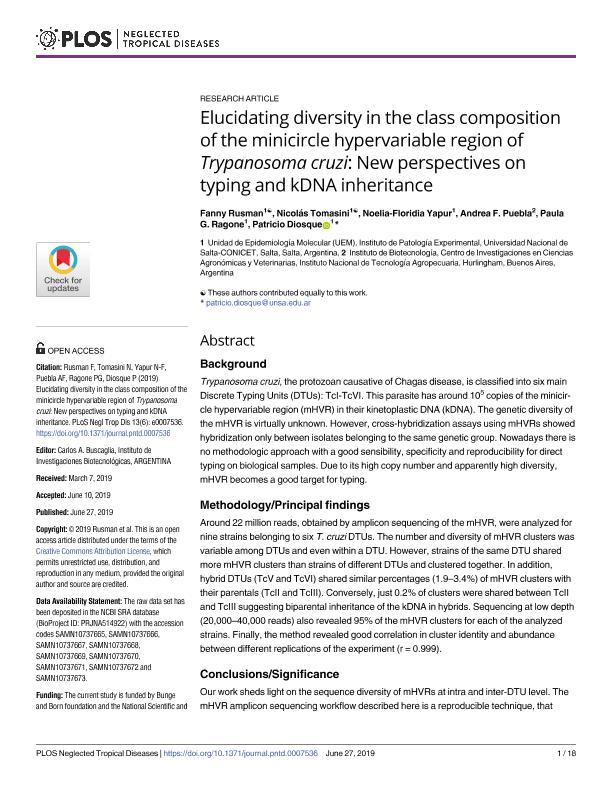Artículo
Elucidating diversity in the class composition of the minicircle hypervariable region of Trypanosoma cruzi: New perspectives on typing and kDNA inheritance
Tomasini, Nicolás ; Rusman, Fanny
; Rusman, Fanny ; Floridia Yapur, Noelia Aldana del Rosario
; Floridia Yapur, Noelia Aldana del Rosario ; Puebla, Andrea Fabiana; Ragone, Paula Gabriela
; Puebla, Andrea Fabiana; Ragone, Paula Gabriela ; Diosque, Patricio
; Diosque, Patricio
 ; Rusman, Fanny
; Rusman, Fanny ; Floridia Yapur, Noelia Aldana del Rosario
; Floridia Yapur, Noelia Aldana del Rosario ; Puebla, Andrea Fabiana; Ragone, Paula Gabriela
; Puebla, Andrea Fabiana; Ragone, Paula Gabriela ; Diosque, Patricio
; Diosque, Patricio
Fecha de publicación:
2019
Editorial:
Public Library of Science
Revista:
Neglected Tropical Diseases
ISSN:
1935-2735
Idioma:
Inglés
Tipo de recurso:
Artículo publicado
Clasificación temática:
Resumen
Background Trypanosoma cruzi, the protozoan causative of Chagas disease, is classified into six main Discrete Typing Units (DTUs): TcI-TcVI. This parasite has around 105 copies of the minicircle hypervariable region (mHVR) in their kinetoplastic DNA (kDNA). The genetic diversity of the mHVR is virtually unknown. However, cross-hybridization assays using mHVRs showed hybridization only between isolates belonging to the same genetic group. Nowadays there is no methodologic approach with a good sensibility, specificity and reproducibility for direct typing on biological samples. Due to its high copy number and apparently high diversity, mHVR becomes a good target for typing. Methodology/Principal findings Around 22 million reads, obtained by amplicon sequencing of the mHVR, were analyzed for nine strains belonging to six T. cruzi DTUs. The number and diversity of mHVR clusters was variable among DTUs and even within a DTU. However, strains of the same DTU shared more mHVR clusters than strains of different DTUs and clustered together. In addition, hybrid DTUs (TcV and TcVI) shared similar percentages (1.9–3.4%) of mHVR clusters with their parentals (TcII and TcIII). Conversely, just 0.2% of clusters were shared between TcII and TcIII suggesting biparental inheritance of the kDNA in hybrids. Sequencing at low depth (20,000–40,000 reads) also revealed 95% of the mHVR clusters for each of the analyzed strains. Finally, the method revealed good correlation in cluster identity and abundance between different replications of the experiment (r = 0.999). Conclusions/Significance Our work sheds light on the sequence diversity of mHVRs at intra and inter-DTU level. The mHVR amplicon sequencing workflow described here is a reproducible technique, that allows multiplexed analysis of hundreds of strains and results promissory for direct typing on biological samples in a future. In addition, such approach may help to gain knowledge on the mechanisms of the minicircle evolution and phylogenetic relationships among strains.
Palabras clave:
TRYPANSOMA CRUZI
,
MINICIRCLES
,
LINEAGES
Archivos asociados
Licencia
Identificadores
Colecciones
Articulos(IPE)
Articulos de INST.DE PATOLOGIA EXPERIMENTAL
Articulos de INST.DE PATOLOGIA EXPERIMENTAL
Citación
Tomasini, Nicolás; Rusman, Fanny; Floridia Yapur, Noelia Aldana del Rosario; Puebla, Andrea Fabiana; Ragone, Paula Gabriela; et al.; Elucidating diversity in the class composition of the minicircle hypervariable region of Trypanosoma cruzi: New perspectives on typing and kDNA inheritance; Public Library of Science; Neglected Tropical Diseases; 13; 6; 2019; 1-18
Compartir
Altmétricas



